Accounting and Financial Reporting: SCP and Retail Industry Impact
VerifiedAdded on 2023/01/23
|9
|1853
|75
Report
AI Summary
This report provides a comprehensive analysis of the accounting and financial reporting practices of Shopping Centres Australia Property Group (SCP), an Australian real estate investment trust. The report begins by identifying and explaining the property valuation methods employed by SCP, emphasizing the use of fair value measurement for investment properties. It then details the flexibility management has in determining the valuation approach, considering factors such as sales growth, competition, and future returns. The report further examines the impact of changes in the Australian retail industry on SCP's financial statements, including alterations to key metrics like profit before tax, EBITDA, and net debt, due to changes in lease accounting and market dynamics. The report highlights the economic impact of industry shifts, including changing consumer preferences, increased competition, and inflation, and concludes by discussing the application of accounting standards like AASB 121 in response to economic changes. The report draws on SCP's 2018 annual report and relevant accounting literature to support its analysis, offering a detailed overview of SCP's financial reporting in a dynamic market environment.
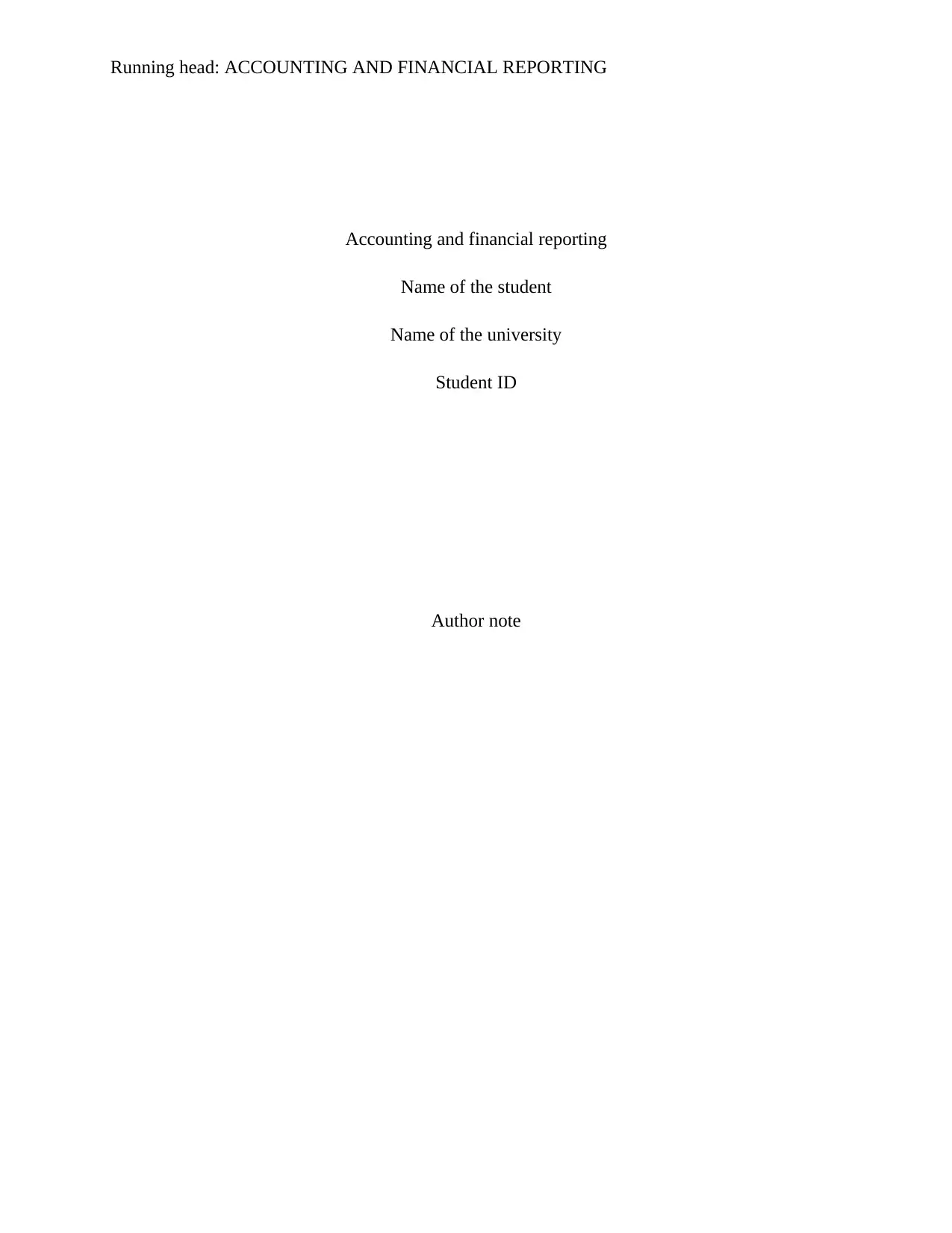
Running head: ACCOUNTING AND FINANCIAL REPORTING
Accounting and financial reporting
Name of the student
Name of the university
Student ID
Author note
Accounting and financial reporting
Name of the student
Name of the university
Student ID
Author note
Paraphrase This Document
Need a fresh take? Get an instant paraphrase of this document with our AI Paraphraser
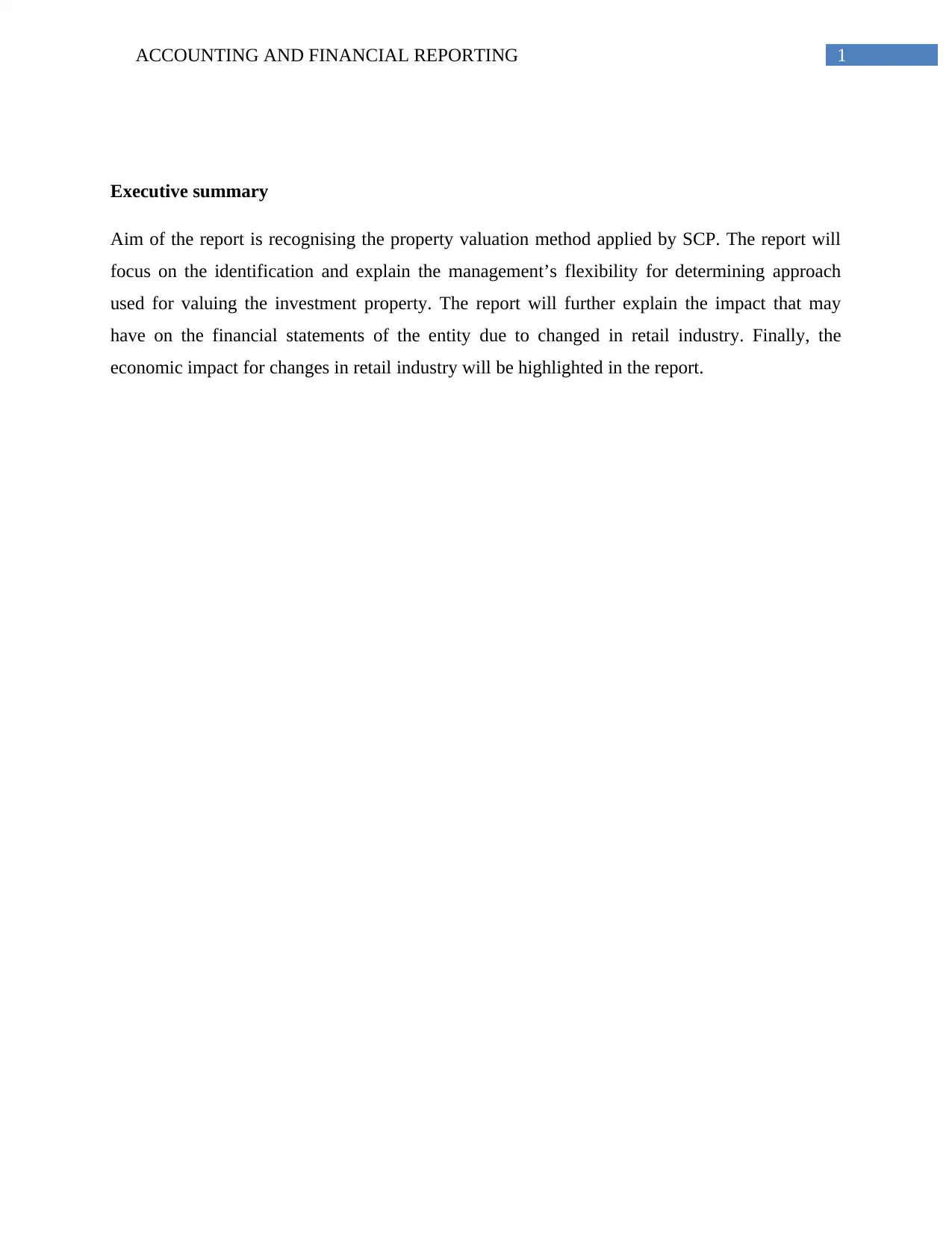
1ACCOUNTING AND FINANCIAL REPORTING
Executive summary
Aim of the report is recognising the property valuation method applied by SCP. The report will
focus on the identification and explain the management’s flexibility for determining approach
used for valuing the investment property. The report will further explain the impact that may
have on the financial statements of the entity due to changed in retail industry. Finally, the
economic impact for changes in retail industry will be highlighted in the report.
Executive summary
Aim of the report is recognising the property valuation method applied by SCP. The report will
focus on the identification and explain the management’s flexibility for determining approach
used for valuing the investment property. The report will further explain the impact that may
have on the financial statements of the entity due to changed in retail industry. Finally, the
economic impact for changes in retail industry will be highlighted in the report.
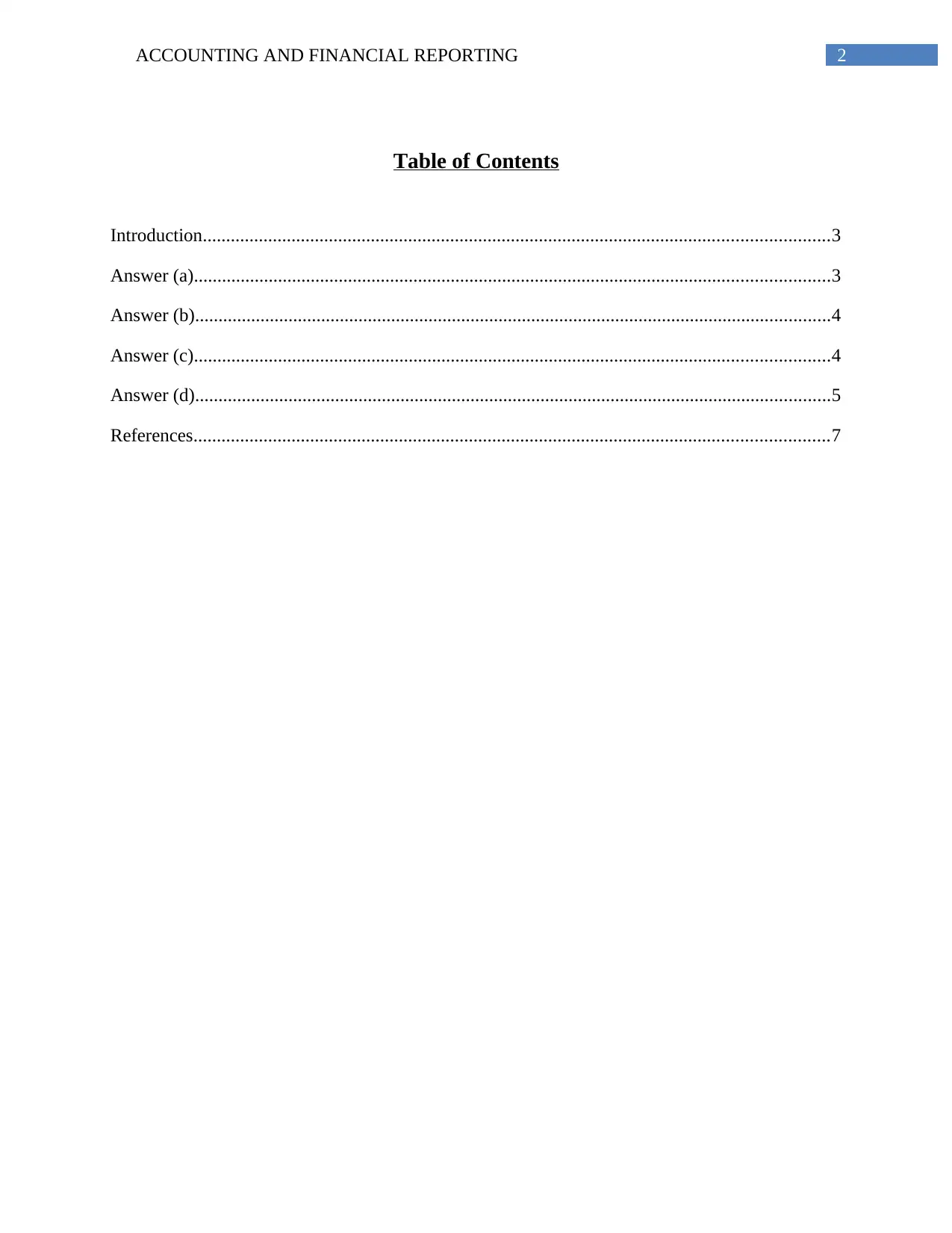
2ACCOUNTING AND FINANCIAL REPORTING
Table of Contents
Introduction......................................................................................................................................3
Answer (a)........................................................................................................................................3
Answer (b)........................................................................................................................................4
Answer (c)........................................................................................................................................4
Answer (d)........................................................................................................................................5
References........................................................................................................................................7
Table of Contents
Introduction......................................................................................................................................3
Answer (a)........................................................................................................................................3
Answer (b)........................................................................................................................................4
Answer (c)........................................................................................................................................4
Answer (d)........................................................................................................................................5
References........................................................................................................................................7
⊘ This is a preview!⊘
Do you want full access?
Subscribe today to unlock all pages.

Trusted by 1+ million students worldwide
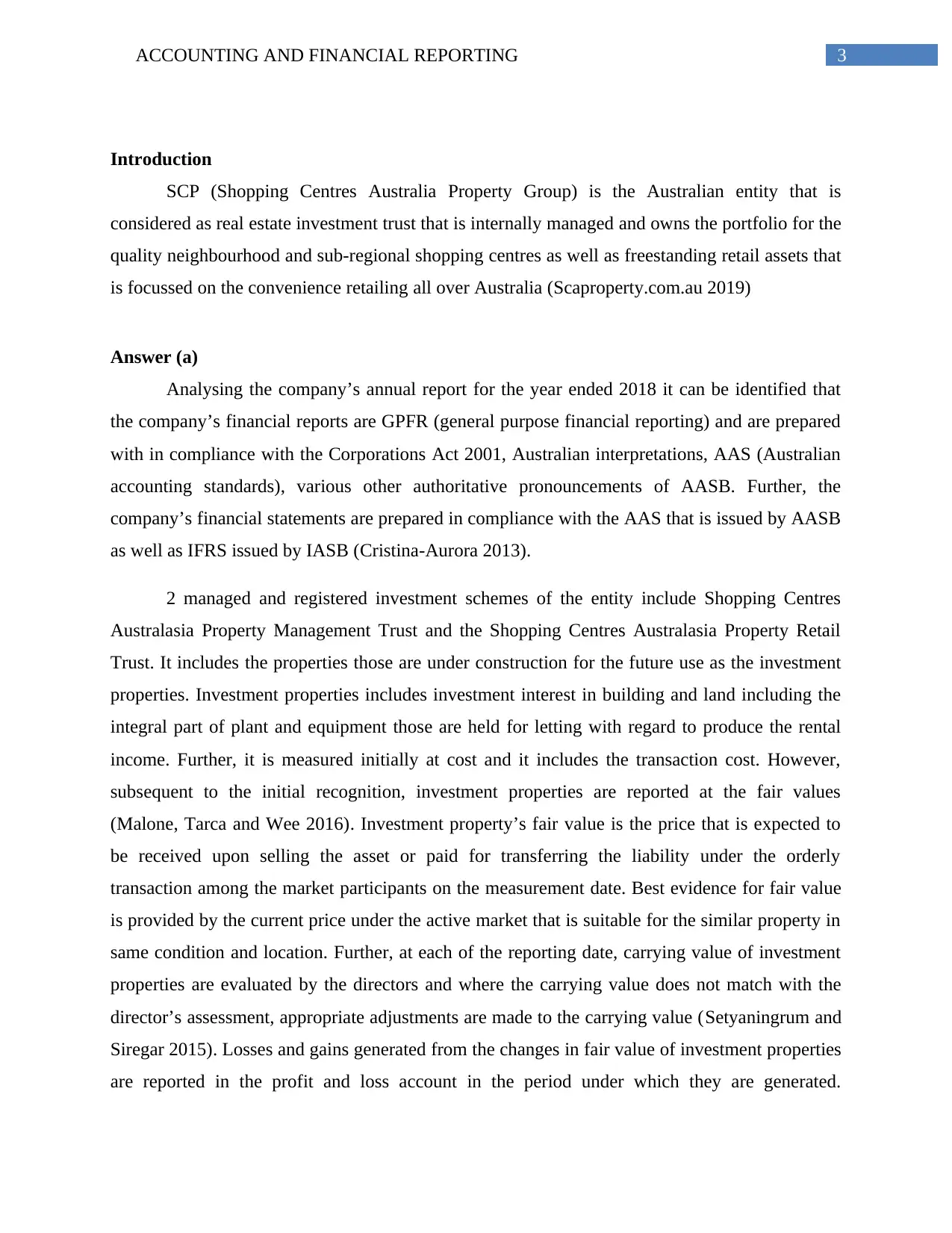
3ACCOUNTING AND FINANCIAL REPORTING
Introduction
SCP (Shopping Centres Australia Property Group) is the Australian entity that is
considered as real estate investment trust that is internally managed and owns the portfolio for the
quality neighbourhood and sub-regional shopping centres as well as freestanding retail assets that
is focussed on the convenience retailing all over Australia (Scaproperty.com.au 2019)
Answer (a)
Analysing the company’s annual report for the year ended 2018 it can be identified that
the company’s financial reports are GPFR (general purpose financial reporting) and are prepared
with in compliance with the Corporations Act 2001, Australian interpretations, AAS (Australian
accounting standards), various other authoritative pronouncements of AASB. Further, the
company’s financial statements are prepared in compliance with the AAS that is issued by AASB
as well as IFRS issued by IASB (Cristina-Aurora 2013).
2 managed and registered investment schemes of the entity include Shopping Centres
Australasia Property Management Trust and the Shopping Centres Australasia Property Retail
Trust. It includes the properties those are under construction for the future use as the investment
properties. Investment properties includes investment interest in building and land including the
integral part of plant and equipment those are held for letting with regard to produce the rental
income. Further, it is measured initially at cost and it includes the transaction cost. However,
subsequent to the initial recognition, investment properties are reported at the fair values
(Malone, Tarca and Wee 2016). Investment property’s fair value is the price that is expected to
be received upon selling the asset or paid for transferring the liability under the orderly
transaction among the market participants on the measurement date. Best evidence for fair value
is provided by the current price under the active market that is suitable for the similar property in
same condition and location. Further, at each of the reporting date, carrying value of investment
properties are evaluated by the directors and where the carrying value does not match with the
director’s assessment, appropriate adjustments are made to the carrying value (Setyaningrum and
Siregar 2015). Losses and gains generated from the changes in fair value of investment properties
are reported in the profit and loss account in the period under which they are generated.
Introduction
SCP (Shopping Centres Australia Property Group) is the Australian entity that is
considered as real estate investment trust that is internally managed and owns the portfolio for the
quality neighbourhood and sub-regional shopping centres as well as freestanding retail assets that
is focussed on the convenience retailing all over Australia (Scaproperty.com.au 2019)
Answer (a)
Analysing the company’s annual report for the year ended 2018 it can be identified that
the company’s financial reports are GPFR (general purpose financial reporting) and are prepared
with in compliance with the Corporations Act 2001, Australian interpretations, AAS (Australian
accounting standards), various other authoritative pronouncements of AASB. Further, the
company’s financial statements are prepared in compliance with the AAS that is issued by AASB
as well as IFRS issued by IASB (Cristina-Aurora 2013).
2 managed and registered investment schemes of the entity include Shopping Centres
Australasia Property Management Trust and the Shopping Centres Australasia Property Retail
Trust. It includes the properties those are under construction for the future use as the investment
properties. Investment properties includes investment interest in building and land including the
integral part of plant and equipment those are held for letting with regard to produce the rental
income. Further, it is measured initially at cost and it includes the transaction cost. However,
subsequent to the initial recognition, investment properties are reported at the fair values
(Malone, Tarca and Wee 2016). Investment property’s fair value is the price that is expected to
be received upon selling the asset or paid for transferring the liability under the orderly
transaction among the market participants on the measurement date. Best evidence for fair value
is provided by the current price under the active market that is suitable for the similar property in
same condition and location. Further, at each of the reporting date, carrying value of investment
properties are evaluated by the directors and where the carrying value does not match with the
director’s assessment, appropriate adjustments are made to the carrying value (Setyaningrum and
Siregar 2015). Losses and gains generated from the changes in fair value of investment properties
are reported in the profit and loss account in the period under which they are generated.
Paraphrase This Document
Need a fresh take? Get an instant paraphrase of this document with our AI Paraphraser
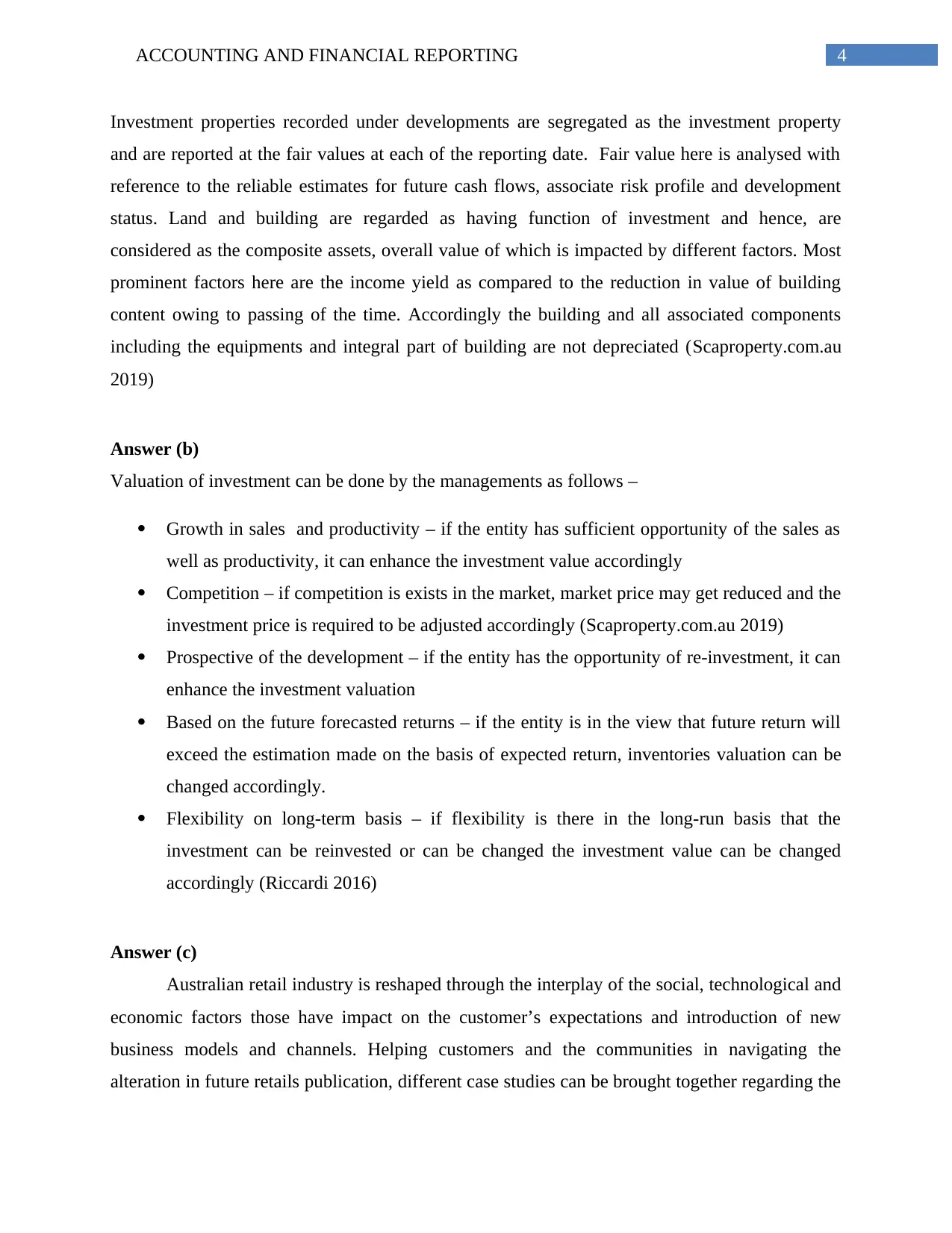
4ACCOUNTING AND FINANCIAL REPORTING
Investment properties recorded under developments are segregated as the investment property
and are reported at the fair values at each of the reporting date. Fair value here is analysed with
reference to the reliable estimates for future cash flows, associate risk profile and development
status. Land and building are regarded as having function of investment and hence, are
considered as the composite assets, overall value of which is impacted by different factors. Most
prominent factors here are the income yield as compared to the reduction in value of building
content owing to passing of the time. Accordingly the building and all associated components
including the equipments and integral part of building are not depreciated (Scaproperty.com.au
2019)
Answer (b)
Valuation of investment can be done by the managements as follows –
Growth in sales and productivity – if the entity has sufficient opportunity of the sales as
well as productivity, it can enhance the investment value accordingly
Competition – if competition is exists in the market, market price may get reduced and the
investment price is required to be adjusted accordingly (Scaproperty.com.au 2019)
Prospective of the development – if the entity has the opportunity of re-investment, it can
enhance the investment valuation
Based on the future forecasted returns – if the entity is in the view that future return will
exceed the estimation made on the basis of expected return, inventories valuation can be
changed accordingly.
Flexibility on long-term basis – if flexibility is there in the long-run basis that the
investment can be reinvested or can be changed the investment value can be changed
accordingly (Riccardi 2016)
Answer (c)
Australian retail industry is reshaped through the interplay of the social, technological and
economic factors those have impact on the customer’s expectations and introduction of new
business models and channels. Helping customers and the communities in navigating the
alteration in future retails publication, different case studies can be brought together regarding the
Investment properties recorded under developments are segregated as the investment property
and are reported at the fair values at each of the reporting date. Fair value here is analysed with
reference to the reliable estimates for future cash flows, associate risk profile and development
status. Land and building are regarded as having function of investment and hence, are
considered as the composite assets, overall value of which is impacted by different factors. Most
prominent factors here are the income yield as compared to the reduction in value of building
content owing to passing of the time. Accordingly the building and all associated components
including the equipments and integral part of building are not depreciated (Scaproperty.com.au
2019)
Answer (b)
Valuation of investment can be done by the managements as follows –
Growth in sales and productivity – if the entity has sufficient opportunity of the sales as
well as productivity, it can enhance the investment value accordingly
Competition – if competition is exists in the market, market price may get reduced and the
investment price is required to be adjusted accordingly (Scaproperty.com.au 2019)
Prospective of the development – if the entity has the opportunity of re-investment, it can
enhance the investment valuation
Based on the future forecasted returns – if the entity is in the view that future return will
exceed the estimation made on the basis of expected return, inventories valuation can be
changed accordingly.
Flexibility on long-term basis – if flexibility is there in the long-run basis that the
investment can be reinvested or can be changed the investment value can be changed
accordingly (Riccardi 2016)
Answer (c)
Australian retail industry is reshaped through the interplay of the social, technological and
economic factors those have impact on the customer’s expectations and introduction of new
business models and channels. Helping customers and the communities in navigating the
alteration in future retails publication, different case studies can be brought together regarding the
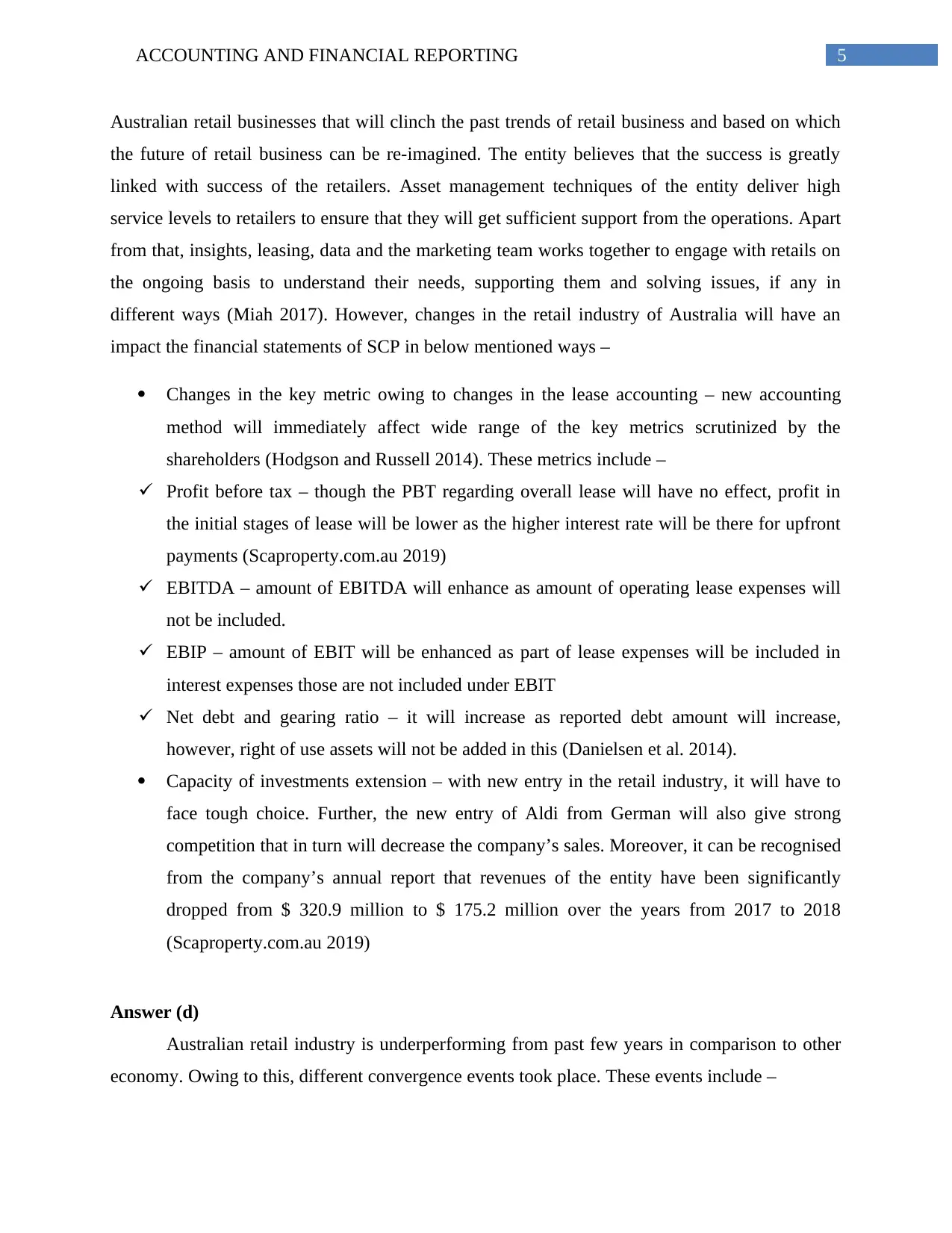
5ACCOUNTING AND FINANCIAL REPORTING
Australian retail businesses that will clinch the past trends of retail business and based on which
the future of retail business can be re-imagined. The entity believes that the success is greatly
linked with success of the retailers. Asset management techniques of the entity deliver high
service levels to retailers to ensure that they will get sufficient support from the operations. Apart
from that, insights, leasing, data and the marketing team works together to engage with retails on
the ongoing basis to understand their needs, supporting them and solving issues, if any in
different ways (Miah 2017). However, changes in the retail industry of Australia will have an
impact the financial statements of SCP in below mentioned ways –
Changes in the key metric owing to changes in the lease accounting – new accounting
method will immediately affect wide range of the key metrics scrutinized by the
shareholders (Hodgson and Russell 2014). These metrics include –
Profit before tax – though the PBT regarding overall lease will have no effect, profit in
the initial stages of lease will be lower as the higher interest rate will be there for upfront
payments (Scaproperty.com.au 2019)
EBITDA – amount of EBITDA will enhance as amount of operating lease expenses will
not be included.
EBIP – amount of EBIT will be enhanced as part of lease expenses will be included in
interest expenses those are not included under EBIT
Net debt and gearing ratio – it will increase as reported debt amount will increase,
however, right of use assets will not be added in this (Danielsen et al. 2014).
Capacity of investments extension – with new entry in the retail industry, it will have to
face tough choice. Further, the new entry of Aldi from German will also give strong
competition that in turn will decrease the company’s sales. Moreover, it can be recognised
from the company’s annual report that revenues of the entity have been significantly
dropped from $ 320.9 million to $ 175.2 million over the years from 2017 to 2018
(Scaproperty.com.au 2019)
Answer (d)
Australian retail industry is underperforming from past few years in comparison to other
economy. Owing to this, different convergence events took place. These events include –
Australian retail businesses that will clinch the past trends of retail business and based on which
the future of retail business can be re-imagined. The entity believes that the success is greatly
linked with success of the retailers. Asset management techniques of the entity deliver high
service levels to retailers to ensure that they will get sufficient support from the operations. Apart
from that, insights, leasing, data and the marketing team works together to engage with retails on
the ongoing basis to understand their needs, supporting them and solving issues, if any in
different ways (Miah 2017). However, changes in the retail industry of Australia will have an
impact the financial statements of SCP in below mentioned ways –
Changes in the key metric owing to changes in the lease accounting – new accounting
method will immediately affect wide range of the key metrics scrutinized by the
shareholders (Hodgson and Russell 2014). These metrics include –
Profit before tax – though the PBT regarding overall lease will have no effect, profit in
the initial stages of lease will be lower as the higher interest rate will be there for upfront
payments (Scaproperty.com.au 2019)
EBITDA – amount of EBITDA will enhance as amount of operating lease expenses will
not be included.
EBIP – amount of EBIT will be enhanced as part of lease expenses will be included in
interest expenses those are not included under EBIT
Net debt and gearing ratio – it will increase as reported debt amount will increase,
however, right of use assets will not be added in this (Danielsen et al. 2014).
Capacity of investments extension – with new entry in the retail industry, it will have to
face tough choice. Further, the new entry of Aldi from German will also give strong
competition that in turn will decrease the company’s sales. Moreover, it can be recognised
from the company’s annual report that revenues of the entity have been significantly
dropped from $ 320.9 million to $ 175.2 million over the years from 2017 to 2018
(Scaproperty.com.au 2019)
Answer (d)
Australian retail industry is underperforming from past few years in comparison to other
economy. Owing to this, different convergence events took place. These events include –
⊘ This is a preview!⊘
Do you want full access?
Subscribe today to unlock all pages.

Trusted by 1+ million students worldwide
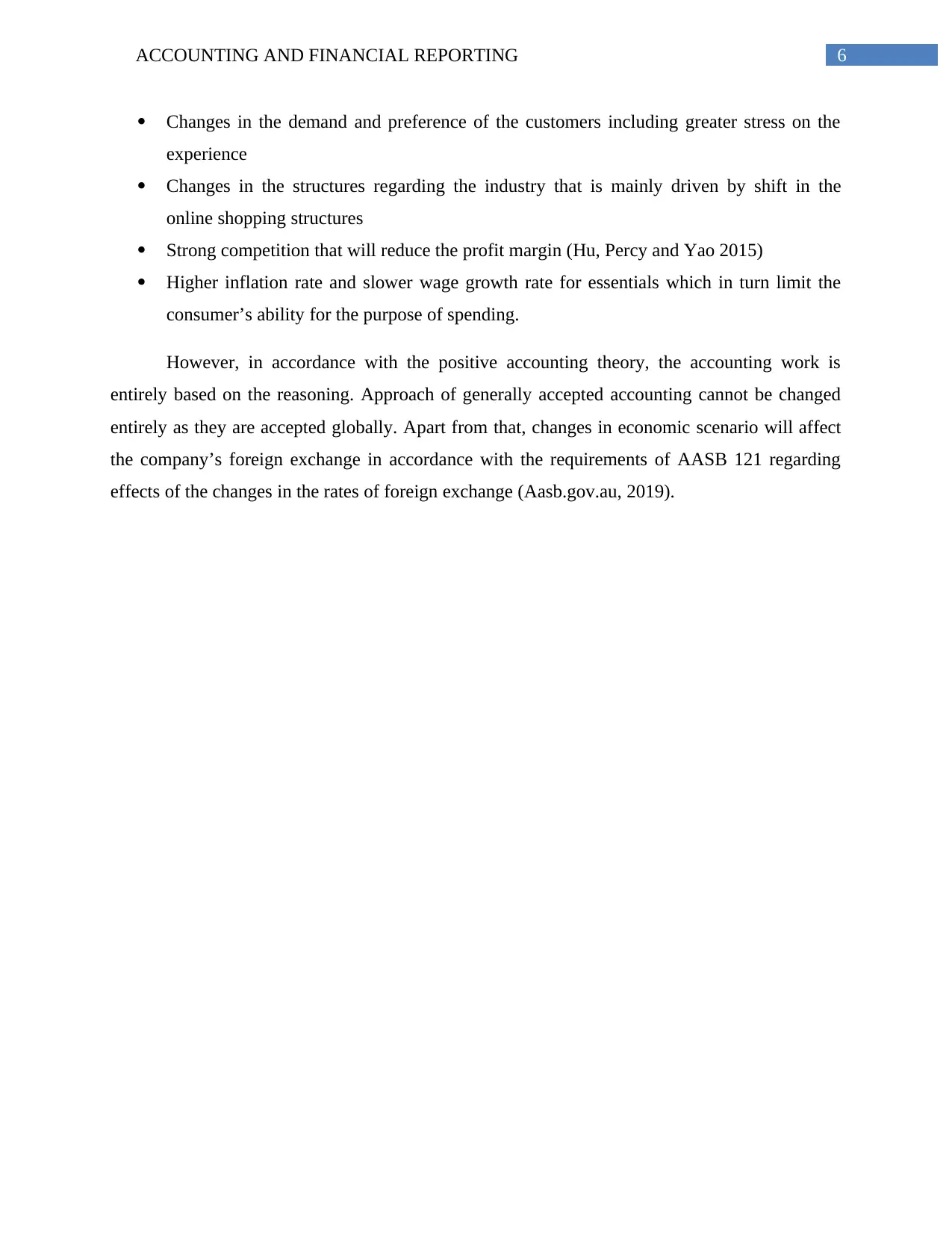
6ACCOUNTING AND FINANCIAL REPORTING
Changes in the demand and preference of the customers including greater stress on the
experience
Changes in the structures regarding the industry that is mainly driven by shift in the
online shopping structures
Strong competition that will reduce the profit margin (Hu, Percy and Yao 2015)
Higher inflation rate and slower wage growth rate for essentials which in turn limit the
consumer’s ability for the purpose of spending.
However, in accordance with the positive accounting theory, the accounting work is
entirely based on the reasoning. Approach of generally accepted accounting cannot be changed
entirely as they are accepted globally. Apart from that, changes in economic scenario will affect
the company’s foreign exchange in accordance with the requirements of AASB 121 regarding
effects of the changes in the rates of foreign exchange (Aasb.gov.au, 2019).
Changes in the demand and preference of the customers including greater stress on the
experience
Changes in the structures regarding the industry that is mainly driven by shift in the
online shopping structures
Strong competition that will reduce the profit margin (Hu, Percy and Yao 2015)
Higher inflation rate and slower wage growth rate for essentials which in turn limit the
consumer’s ability for the purpose of spending.
However, in accordance with the positive accounting theory, the accounting work is
entirely based on the reasoning. Approach of generally accepted accounting cannot be changed
entirely as they are accepted globally. Apart from that, changes in economic scenario will affect
the company’s foreign exchange in accordance with the requirements of AASB 121 regarding
effects of the changes in the rates of foreign exchange (Aasb.gov.au, 2019).
Paraphrase This Document
Need a fresh take? Get an instant paraphrase of this document with our AI Paraphraser
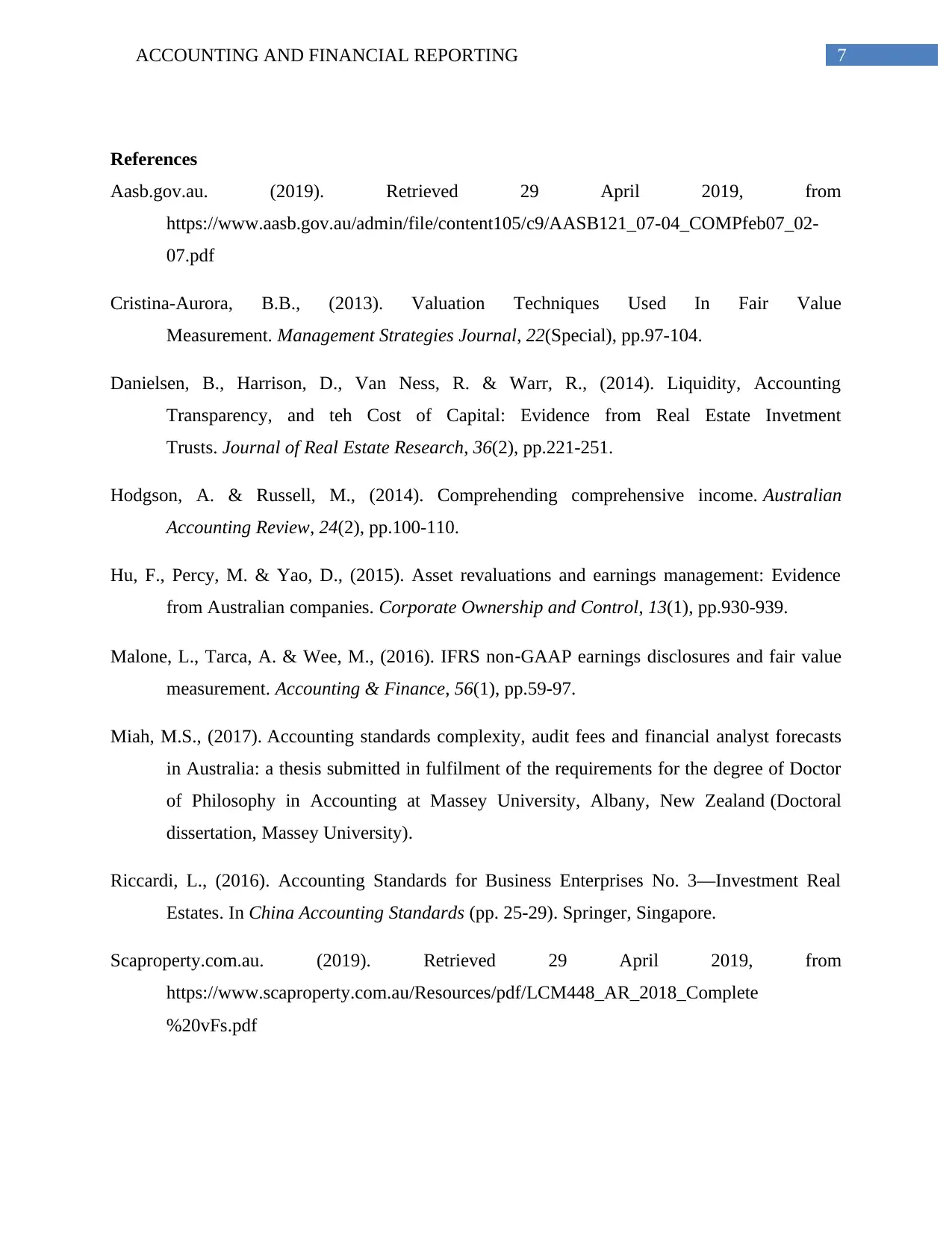
7ACCOUNTING AND FINANCIAL REPORTING
References
Aasb.gov.au. (2019). Retrieved 29 April 2019, from
https://www.aasb.gov.au/admin/file/content105/c9/AASB121_07-04_COMPfeb07_02-
07.pdf
Cristina-Aurora, B.B., (2013). Valuation Techniques Used In Fair Value
Measurement. Management Strategies Journal, 22(Special), pp.97-104.
Danielsen, B., Harrison, D., Van Ness, R. & Warr, R., (2014). Liquidity, Accounting
Transparency, and teh Cost of Capital: Evidence from Real Estate Invetment
Trusts. Journal of Real Estate Research, 36(2), pp.221-251.
Hodgson, A. & Russell, M., (2014). Comprehending comprehensive income. Australian
Accounting Review, 24(2), pp.100-110.
Hu, F., Percy, M. & Yao, D., (2015). Asset revaluations and earnings management: Evidence
from Australian companies. Corporate Ownership and Control, 13(1), pp.930-939.
Malone, L., Tarca, A. & Wee, M., (2016). IFRS non‐GAAP earnings disclosures and fair value
measurement. Accounting & Finance, 56(1), pp.59-97.
Miah, M.S., (2017). Accounting standards complexity, audit fees and financial analyst forecasts
in Australia: a thesis submitted in fulfilment of the requirements for the degree of Doctor
of Philosophy in Accounting at Massey University, Albany, New Zealand (Doctoral
dissertation, Massey University).
Riccardi, L., (2016). Accounting Standards for Business Enterprises No. 3—Investment Real
Estates. In China Accounting Standards (pp. 25-29). Springer, Singapore.
Scaproperty.com.au. (2019). Retrieved 29 April 2019, from
https://www.scaproperty.com.au/Resources/pdf/LCM448_AR_2018_Complete
%20vFs.pdf
References
Aasb.gov.au. (2019). Retrieved 29 April 2019, from
https://www.aasb.gov.au/admin/file/content105/c9/AASB121_07-04_COMPfeb07_02-
07.pdf
Cristina-Aurora, B.B., (2013). Valuation Techniques Used In Fair Value
Measurement. Management Strategies Journal, 22(Special), pp.97-104.
Danielsen, B., Harrison, D., Van Ness, R. & Warr, R., (2014). Liquidity, Accounting
Transparency, and teh Cost of Capital: Evidence from Real Estate Invetment
Trusts. Journal of Real Estate Research, 36(2), pp.221-251.
Hodgson, A. & Russell, M., (2014). Comprehending comprehensive income. Australian
Accounting Review, 24(2), pp.100-110.
Hu, F., Percy, M. & Yao, D., (2015). Asset revaluations and earnings management: Evidence
from Australian companies. Corporate Ownership and Control, 13(1), pp.930-939.
Malone, L., Tarca, A. & Wee, M., (2016). IFRS non‐GAAP earnings disclosures and fair value
measurement. Accounting & Finance, 56(1), pp.59-97.
Miah, M.S., (2017). Accounting standards complexity, audit fees and financial analyst forecasts
in Australia: a thesis submitted in fulfilment of the requirements for the degree of Doctor
of Philosophy in Accounting at Massey University, Albany, New Zealand (Doctoral
dissertation, Massey University).
Riccardi, L., (2016). Accounting Standards for Business Enterprises No. 3—Investment Real
Estates. In China Accounting Standards (pp. 25-29). Springer, Singapore.
Scaproperty.com.au. (2019). Retrieved 29 April 2019, from
https://www.scaproperty.com.au/Resources/pdf/LCM448_AR_2018_Complete
%20vFs.pdf

8ACCOUNTING AND FINANCIAL REPORTING
Setyaningrum, D. and Siregar, S.V., (2015). The Value Relevance of Foreign Translation
Adjustment: Case of Indonesia. Academy of Accounting and Financial Studies
Journal, 19(2), p.251.
Setyaningrum, D. and Siregar, S.V., (2015). The Value Relevance of Foreign Translation
Adjustment: Case of Indonesia. Academy of Accounting and Financial Studies
Journal, 19(2), p.251.
⊘ This is a preview!⊘
Do you want full access?
Subscribe today to unlock all pages.

Trusted by 1+ million students worldwide
1 out of 9
Related Documents
Your All-in-One AI-Powered Toolkit for Academic Success.
+13062052269
info@desklib.com
Available 24*7 on WhatsApp / Email
![[object Object]](/_next/static/media/star-bottom.7253800d.svg)
Unlock your academic potential
Copyright © 2020–2025 A2Z Services. All Rights Reserved. Developed and managed by ZUCOL.





